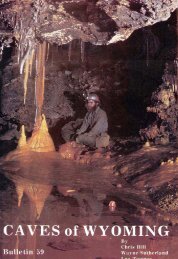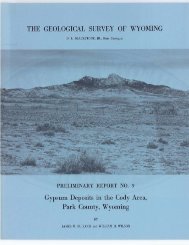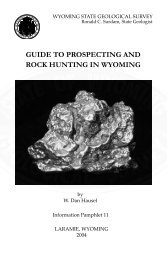The Dinosaurs of Wyoming - Wyoming State Geological Survey ...
The Dinosaurs of Wyoming - Wyoming State Geological Survey ...
The Dinosaurs of Wyoming - Wyoming State Geological Survey ...
You also want an ePaper? Increase the reach of your titles
YUMPU automatically turns print PDFs into web optimized ePapers that Google loves.
68 THE DINOSAuRS OF WYOMIITG<br />
<strong>of</strong> the sand-grains themselves show them to be angular with<br />
slightly abraded corners, sand <strong>of</strong> aqueous deposit; but apparently<br />
laid down in a lake or bayou. rather than in a normal<br />
river as indicated by the absence <strong>of</strong> clay and the presence <strong>of</strong> a<br />
lime cement. <strong>The</strong> cross-bedding which the rock exhibits could<br />
readily have been made by wave action along the shores <strong>of</strong> a<br />
comparatively shallow delta-lake or bay, and the track, which<br />
FIGURE 17A<br />
Fossil footprints <strong>of</strong> three·toed <strong>Dinosaurs</strong> from the Newark series, Triassic, <strong>of</strong> the<br />
Connecticut Valley. <strong>The</strong>se are preserved in Yale University Museum. Note the small<br />
tracks in larger slab.-Courtesy <strong>of</strong> Pr<strong>of</strong>essor R. S. Lull.<br />
is that <strong>of</strong> a very young animal, was evidently made under water.<br />
<strong>The</strong> character <strong>of</strong> the sediment does not give evidence <strong>of</strong> much<br />
vegetable matter at the particular point where the track was<br />
made. <strong>The</strong> footprint is that which one would expect from the<br />
known character <strong>of</strong> the sauropod foot, and is evenly impressed<br />
throughout as though the animal's weight were borne equally<br />
over the entire sole, evidence in favor <strong>of</strong> a true walk rather than<br />
a sprawling crawl, at any rate when the body was partly waterborne.<br />
"I believe these animals to have been truly aquatic though<br />
capable <strong>of</strong> coming ashore where the substratum was sufficiently<br />
firm to support the immense weight, and, while they show no<br />
trace <strong>of</strong> swimming appendages, they doubtless could swim as a<br />
hippopotamus does."














